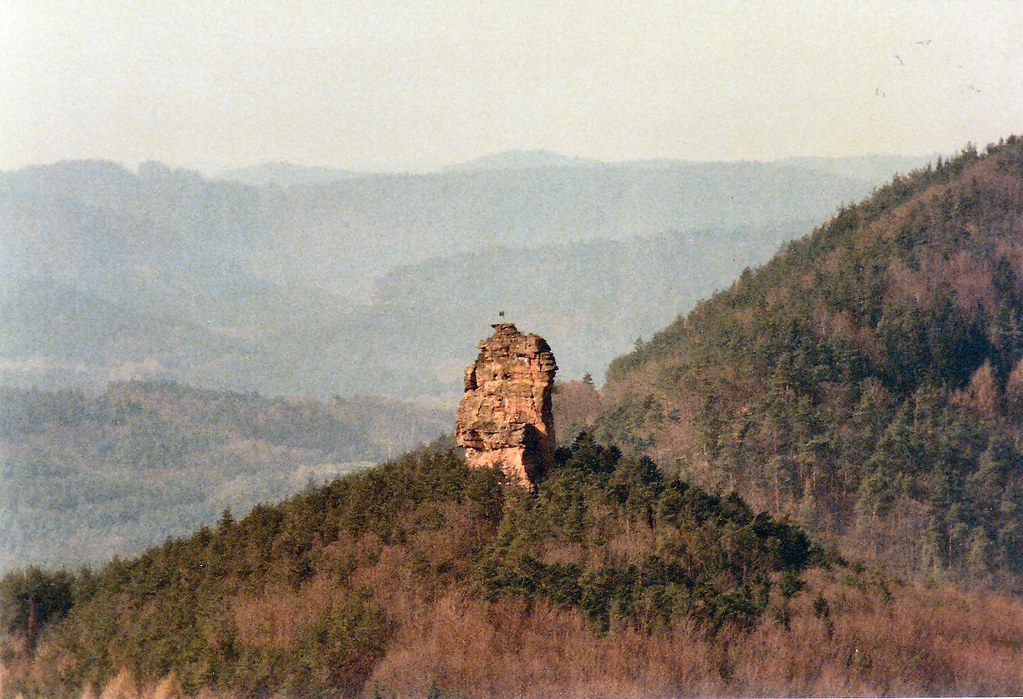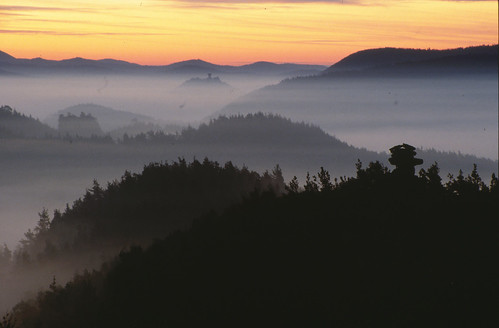Drachenfels Castle (Wasgau)
Drachenfels castle ruins
The ruins of Drachenfels Castle is the remains of a rock castle near the village Busenberg the German part of Wasgau, the southern part of the Palatinate forest ( state of Rhineland -Palatinate).
Location
About seven miles north of the border between Germany and France, the Drachenfels Castle is located on the same 150 -meter red sandstone rock, which extends 368 meters in altitude on a mountain ridge. The highest part of the castle rock was expanded to keep. Because of the current appearance of the tower rest is popularly called " molar tooth "; he makes the ruin of one of the most striking castles in Rhineland- Palatinate.
Near the Drachenfels, there are other historic castles: Only three kilometers south-east and north-west lie the Berwartstein and the three -part Dahn Castle Group, Lindelbrunn located 6 km north-east, and the castle group at the German - French border with Wegelnburg ( German ) and High Castle, Lowenstein and Fleckenstein (all on the French side ) in the southwest is ten kilometers away.
In one of the castle opposite rock solid on the 420 meter high mountain heath, called the Book Chamber Rock, the heath chambers were hewn. Time of origin and former function are unknown, it is speculated that this could have found one belonging to the Drachenfels sentry there.
Name and history
The name of the castle could be caused by the image of a dragon, which is carved into the sandstone wall of the former castle hall. Since, however, is unknown, when it was made, there is also the possibility that the dragon effigy reference was made to the existing name of the castle.
The origins of the castle are largely unknown. Archaeological finds are of the castle can be dated to the middle of the 13th century, but the facility was built in the early 12th century. 1209 the brothers Konrad and Wilhelm von Drachenfels were first documented. Johann Lehmann (1797-1876) named without supporting documents 1219-1221 Burkhard one of the Drachenfels, who had been in Staufen services. Other documents noted that a dispute between the cousins Rudolf and Anselm von Drachenfels with the bishop of Worms in 1288 was settled; the oldest preserved seal these two cousins contains a kite in a pointed shield. Since the early 14th century the seal contains a Stag or a wild goose. The first Niederadlige who was brought beyond doubt with a castle in the Wasgau in conjunction, 1245 Walter von Drachenfels (also Waltherus de Drachenvels ).
1314 the Lords of Drachenfels were awarded compensation for an expedition against the city of Strasbourg Berwartstein in which the nearby castle Drachenfels was also besieged and damaged. In 1335 there were disputes with the city of Strasbourg, where the men were described by Drachenfels as robber barons. During this time the Drachenfels Castle was besieged and partially destroyed, so that the lords were forced from 1344 to sell gradually parts of the castle. Thus, the Drachenfels to Ganerbenburg, in which several people or family clans divided the land.
1510 also gained the rebellious knight Franz von Sickingen a Ganerbenanteil. After Sickingen defeat by the allied armies of three imperial princes, the castle on May 10, 1523 was finally destroyed by the victors, although the castellan, who had eight servants alone attend, she had surrendered without a fight in the face of tremendous odds. The winners prohibited reconstruction.
What was left out or on the grinds of the castle, was further destroyed by the use of the ruins as a quarry. A descendant of the owner, Baron Franz Christoph Eckbrecht of Durkheim, established in 1778 with stones from the Drachenfels in the village Busenberg a country manor house, which is called " castle" today. The Breast Berger church was also built from stones of the ruin.
Plant
Eastern castle rock and older lower castle
The modest remains of the castle in the eastern area are dominated by the so-called molar tooth, the castle rock in the east. On the rock wall a few original features have been preserved. Nevertheless, conveys a climb through the partially carved into the rock sunrises an idea of the valor of the plant. On the plateau of the former donjon the remains of a cistern find. Chiselled into the rock chambers, beam holes and traversals of the sandstone cliffs prove that he was once almost completely surrounded by half-timbered or stone buildings.
Many more buildings is obtained from the lower castle and the gate system. 1903 already the gate tower was completed by two arched portals. Remains of two other towers, a small kennel and walls and buildings since 1990 focus of conservation and excavation activities under the " General Cultural Heritage Rhineland -Palatinate ".
One first enters the tower, which was indeed added later, but consistently consisted of rough stone with forceps holes. Then numerous stone marks can be seen. The stairway to the upper castle was a style similar to the older rock tower. Today is between the two gate towers, a staircase, originally there were probably a rider stairs. In the courtyard of the castle two farm buildings are partly preserved. At the basement entrance of the western building, the year can be seen in 1515. In the basement of another building there is the now blocked up the castle well.
Western Castle Rock and younger lower castle
Well in the late period of the castle of somewhat lower preferred western castle rock was also built. Cause of such extensions are usually changes in the possession of castles, such as conversion of the original fief in a Ganerbschaft. On the formerly cultivated West Rocks but no more walls are visible, it is not even accessible. Parts of the east and a police station on the south side of the rock have been preserved.
The plant on the western cliffs had a separate small sub castle and a separate gate system southeast of the castle rock, are obtained from the remains of a Flankierungsturms with mouth slits. At installation of castle building on the western castle rock of the former moat was built over a multi-storey building. From this, only the beam holes are present, of which pierce through multiple carved into the rock, the older dragon image. To the north of the farm was closed by a semicircular wall.










